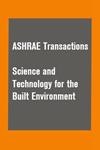Developing a standardized categorization system for energy efficiency measures (1836-RP)
IF 1.7
4区 工程技术
Q3 CONSTRUCTION & BUILDING TECHNOLOGY
Science and Technology for the Built Environment
Pub Date : 2023-11-08
DOI:10.1080/23744731.2023.2279466
引用次数: 1
Abstract
AbstractThe growth of legislation to reduce energy use in existing buildings is producing a rich new trove of data about energy efficiency measures (EEMs), which has the potential to unlock new insights into the built environment. However, the lack of standardized EEM naming conventions and categorization methods is currently a major barrier to aggregating and analyzing this data. The goal of this study was to develop and test a novel standardized system for categorizing EEMs. The system consists of two components: a three-level building element-based categorization hierarchy, and a set of measure name tags, which are used to label an EEM and categorize it on the hierarchy. A demonstration and testing process was developed and applied to two sample datasets to evaluate the ability of the system to categorize a variety of EEMs. The results show that most EEMs can easily be categorized manually according to the new system, and highlight several challenges for automated categorization, including EEM names that are missing an element, contain a term not in the tag list, or contain synonyms or abbreviations. These results provide a replicable and systematic framework for the translation, aggregation, and analysis of EEM datasets from different sources.DisclaimerAs a service to authors and researchers we are providing this version of an accepted manuscript (AM). Copyediting, typesetting, and review of the resulting proofs will be undertaken on this manuscript before final publication of the Version of Record (VoR). During production and pre-press, errors may be discovered which could affect the content, and all legal disclaimers that apply to the journal relate to these versions also.制定能源效率措施的标准化分类系统(1836-RP)
【摘要】减少现有建筑能源使用的立法正在产生丰富的关于能源效率措施(EEMs)的新数据,这些数据有可能开启对建筑环境的新见解。然而,缺乏标准化的EEM命名约定和分类方法是目前聚合和分析这些数据的主要障碍。本研究的目的是开发和测试一种新的标准化系统来分类eem。该系统由两个组件组成:一个基于三层构建元素的分类层次结构,以及一组度量名称标签,这些标签用于标记EEM并在层次结构上对其进行分类。开发了一个演示和测试过程,并将其应用于两个样本数据集,以评估系统对各种eem进行分类的能力。结果表明,大多数EEM可以很容易地根据新系统手动分类,并突出了自动分类的几个挑战,包括EEM名称缺少元素,包含不在标记列表中的术语,或包含同义词或缩写。这些结果为来自不同来源的EEM数据集的翻译、聚合和分析提供了一个可复制的系统框架。免责声明作为对作者和研究人员的服务,我们提供了这个版本的已接受的手稿(AM)。在最终出版版本记录(VoR)之前,将对该手稿进行编辑、排版和审查。在制作和印前,可能会发现可能影响内容的错误,所有适用于期刊的法律免责声明也与这些版本有关。
本文章由计算机程序翻译,如有差异,请以英文原文为准。
求助全文
约1分钟内获得全文
求助全文
来源期刊

Science and Technology for the Built Environment
THERMODYNAMICSCONSTRUCTION & BUILDING TECH-CONSTRUCTION & BUILDING TECHNOLOGY
CiteScore
4.30
自引率
5.30%
发文量
78
期刊介绍:
Science and Technology for the Built Environment (formerly HVAC&R Research) is ASHRAE’s archival research publication, offering comprehensive reporting of original research in science and technology related to the stationary and mobile built environment, including indoor environmental quality, thermodynamic and energy system dynamics, materials properties, refrigerants, renewable and traditional energy systems and related processes and concepts, integrated built environmental system design approaches and tools, simulation approaches and algorithms, building enclosure assemblies, and systems for minimizing and regulating space heating and cooling modes. The journal features review articles that critically assess existing literature and point out future research directions.
 求助内容:
求助内容: 应助结果提醒方式:
应助结果提醒方式:


